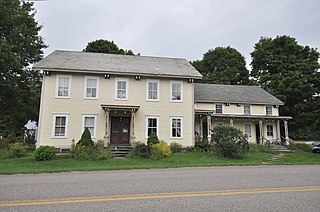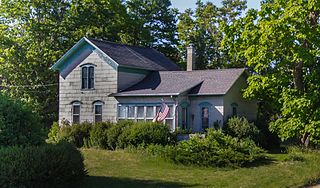Westphalia is a small unincorporated community in Falls County, Texas, United States located 35 mi (56 km) south of Waco on State Highway 320. Westphalia has a strong German and Catholic background. The Church of the Visitation was, until recently, the largest wooden church west of the Mississippi River. Westphalia is mainly noted for its historic church and convents, but also for its meat market and for its annual church picnic, which is one of the largest in the area. Westphalia is also known for the Westphalia Waltz.

The George and Mary Pine Smith House is a private house located at 3704 Sheldon Road, near Sheldon in Canton Township, Michigan. It was listed on the National Register of Historic Places in 2000.

The Franklin Harris Farmstead is a historic farm complex located outside the village of Salem in Columbiana County, Ohio, United States. Once home to a prominent former soldier, the farmstead includes a high-style farmhouse from the 1890s, and it has been named a historic site.
The John and Katharine Tunkun Podjun Farm is a farm located at 9581 East 1 Mile Road in Ellsworth, Michigan. It was listed on the National Register of Historic Places in 2002.

Lenhart Farmhouse is a historic farmhouse in Root Township, Adams County, Indiana. It was built about 1848, and was listed on the National Register of Historic Places in 2002.

The Stahly–Nissley–Kuhns Farm is a historic farm located at Nappanee, Elkhart County, Indiana. Nappanee was established in 1874. The Farm is part of Amish Acres, which includes the old farmstead and additional structures brought in to show Amish life.

The Aaron Jr. and Susan Parker Farm is a historic farm property at 1715 Brook Road in Cavendish, Vermont. Now just 16 acres (6.5 ha), the property includes a c. 1815 Federal style farmhouse, and a well-preserved early 19th century English barn. The farmstead was listed on the National Register of Historic Places in 2014.

The Martin M. Bates Farmstead is a historic farm property on Huntington Road in Richmond, Vermont. Farmed since the 1790s, the property is now a well-preserved example of a mid-19th century dairy farm, with a fine Italianate farmhouse. The property was listed on the National Register of Historic Places in 1991.

The Rock S. Edwards Farmstead is a collection of farm buildings located at 3503 Edwards Road in Sodus Township, Michigan. It was listed on the National Register of Historic Places in 1995.

The Jacob and Rebecca Fuerst Farmstead was a farm located at 24000 Taft Road in Novi, Michigan. It was listed on the National Register of Historic Places in 1997. The farm was demolished in 2008 and the property redeveloped into Fuerst Park.

The Langford and Lydia McMichael Sutherland Farmstead is a farm located at 797 Textile Road in Pittsfield Charter Township, Michigan. It was listed on the National Register of Historic Places in 2006. It is now the Sutherland-Wilson Farm Historic Site.

The August Westphal Farmstead is a group of farm buildings located at 6430 Brighton Road near Brighton, Michigan. It was listed on the National Register of Historic Places in 1985.

The Frank J. Hecox House, also known as the House of the Seven Gables, is a single-family home located at 3720 West Grand River Avenue near Howell, Michigan. It was listed on the National Register of Historic Places in 1994. It is a rare example of Second Empire architecture in the region.

The George Louk Farm is a rural farmstead located at 1885 Tooley Road near Howell, Michigan. It was listed on the National Register of Historic Places in 1995.

The Timothy and Lucretia Jones Warner Homestead is a farmstead and archaeological site located at 4001 Pleasant Valley Road near Brighton, Michigan.

The William Horton Farmhouse is a single family home located at 1647 West Miller Road near Morrice, Michigan. It was listed on the National Register of Historic Places in 1986. It is one of the finest rural Italianate farm homes in the area.

The Waterloo Farm Museum is a museum located at 9998 Waterloo-Munith Road in Waterloo Township, Michigan. It was originally the Siebold Farm and then the Realy Farm. The farm was listed on the National Register of Historic Places in 1973.

The Gordon Hitt Farmstead is a former farm located at 4561 North Lake Road near Clark Lake, Michigan. It was listed on the National Register of Historic Places in 1994. It now serves as a vacation rental.

The Fanckboner-Nichols Farmstead is a farmhouse and associated buildings located at 5992 West VW Avenue in Prairie Ronde Township, Michigan. It was listed on the National Register of Historic Places in 2007.

The Benjamin and Maria (Ogden) Drake Farm, also known as the Drake Farmstead, is a farmstead located at 927 North Drake Road in Kalamazoo, Michigan. It was listed on the National Register of Historic Places in 2012.1





















